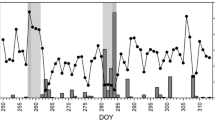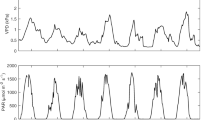Abstract
Whole-tree water use of nine Pinus cembra trees was estimated in the treeline ecotone of the Central Austrian Alps. Sap flow density using Granier-type thermal dissipation probes and environmental parameters was monitored along an elevational gradient from the forest limit up to treeline and finally mediating the krummholz limit throughout two growing seasons. Normalized sap flow density (Q s) was significantly correlated with solar radiation (R s) and vapor pressure deficit (D) throughout the treeline ecotone. Multiple regression analysis indicated that at the forest limit and at treeline, D had a similar effect on Q s than R s. At the krummholz limit by contrast, D had a greater effect on Q s than R s due to partially stomatal closure and wind-induced clustering of the needles, which impaired their response to available irradiance. Whole-tree water use scaled to crown surface area estimated for an entire growing (172 days) declined from 449 mm at the forest limit to 274 mm at treeline and was 251 mm at the krummholz limit, which is within the values estimated for other European forest ecosystems. Nevertheless, the observation above the forest limit in the central Tyrolean Alps tree transpiration scaled to crown surface area is comparable to the water use of adjacent low-stature vegetation, which should also be taken into account when forecasting potential effects of global change on the water balance of the treeline ecotone.






Similar content being viewed by others
References
Anfodillo T, Rento S, Carraro V, Furlanetto L, Urbinati C, Carrer M (1998) Tree water relations and climatic variations at the alpine timberline: seasonal changes of sap flux and xylem water potential in Larix decidua Miller, Picea abies (L.) Karst. and Pinus cembra L. Ann For Sci 55:159–172
Aulitzky H (1984) The microclimatic conditions in a subalpine forest as basis for the management. Geo J 8:277–281
Caldwell MM (1970a) The effect of wind on stomatal aperture, photosynthesis, and transpiration of Rhododendron ferrugineum L. and Pinus cembra L. Centralb Ges Forstwes 87:193–201
Caldwell MM (1970b) Plant gas exchange at high wind speeds. Plant Physiol 46:535–537
Cermák J, Cienciala E, Kucera J, Hällgren JE (1992) Radial velocity profiles of water flow in trunks of Norway spruce and oak and the response of oak to severing. Tree Physiol 10:367–380
Ewers BE, Oren R, Albaugh TJ, Dougherty PM (1999) Carry-over effects of water and nutrient supply on water use of Pinus taeda. Ecol Appl 9:513–525
Granier A (1985) Une nouvelle méthode pour la mesure de flux de sève brute dans le tronc des arbres. Ann For Sci 42:193–200
Gruber A, Zimmenmann J, Wieser G, Oberhuber W (2009) Effects of climate variables on intra-annual stem radial increment in Pinus cembra (L.) along the timberline ecotone. Ann For Sci 66:503
Gruber A, Pirkebner D, Oberhuber W, Wieser G (2011) Spatial and seasonal variations in mobile carbohydrates in Pinus cembra in the treeline ecotone of the Central Austrian Alps. Eur J For Res 130:173–179
Hogg EH, Hurdle PA (1997) Sap flow in trembling aspen: implications for stomatal responses to vapour pressure deficit. Tree Physiol 17:501–509
IPCC (2007) Climate change 2007. Cambridge University Press, Cambridge
Jarvis PG, McNaughton KG (1986) Stomatal control of transpiration: scaling up from leaf to region. Adv Ecol Res 15:1–49
Köstner B, Schulze E-D, Kelliher FM, Holliger DY, Byers JN, Hunt JE, McSeveny TM, Meserth R, Weir PL (1992) Transpiration and canopy conductance in a pristine broad-leaved forest of Nothofagus: an analysis of xylem sap flow and eddy correlation measurements. Oecologia 91:350–359
Kronfuss H (1997) Das Klima einer Hochlagenaufforstung in der subapinen Höhenstufe—Haggen im Sellraintal bei St. Siegmund, Tirol (Periode 1975–1994). Schriftenreihe der Forstl Bundesvers Wien, FBVA Bericht 100
Larcher W (2001) Ökophysiologie der Pflanzen: Leben, Leistung und Stressbewältigung der Pflanzen in ihrer Umwelt. Ulmer, Stuttgart
Lopushinsky W (1986) Seasonal and diurnal trends of heat pulse velocity in Douglas-fir and ponderosa pine. Can J For Res 16:814–821
Matyssek R, Wieser G, Patzner K, Blaschke H, Häberle K-H (2009) Transpiration of forest trees and stands at different altitude: consistencies rather than contrasts? Eur J For Res 128:579–596
Nadezhdina N, Cermak J, Ceulemans R (2002) Radial patterns of sap flow in woody stems of dominant and understory species: scaling errors associated with positioning of sensors. Tree Physiol 22:907–918
Oren R, Phillips N, Katul G, Ewers BE, Pataki DE (1998) Scaling xylem sap flux and soil water balance and calculating variance. A method for partitioning water flux in forests. Ann For Sci 55:191–216
Pallardy SG, Cermák J, Ewers FW, Kaufmann MR, Parker WC, Sperry JS (1995) Water transport dynamics in trees and stands. In: Smith WK, Hinckley TM (eds) Resource physiology on conifers: acquisition, allocation and utilization. Academic Press, San Diego, pp 301–389
Roberts JM (1983) Forest transpiration: a conservative hydrological process? J Hydrol 66:133–141
Tranquillini W (1979) Physiological ecology of the alpine timberline. Tree existence at high altitudes with special reference to the European Alps. Ecological studies, vol 31. Springer, Berlin
Wieser G (2002a) Exchange of trace gases at the tree—atmosphere interface: ozone. In: Gasche R, Papen H, Rennenberg H (eds) Trace gas exchange in forest ecosystems. Tree physiology, vol 3. Kluwer, Dordrecht, pp 211–226
Wieser G (2002b) The role of sapwood temperature variations within Pinus cembra on calculated stem respiration: implications for upscaling and predicted global warming. Phyton 42:1–11
Wieser G (2012) Lessons from the timberline ecotone in the Central Tyrolean Alps: a review. Plant Ecol Divers 5:127–139
Wieser G, Bahn M (2004) Seasonal and spatial variation of woody-tissue respiration in a Pinus cembra tree at the alpine timberline in the Central Austrian Alps. Trees 18:576–580
Wieser G, Leo M (2012) Whole tree water use by Pins cembra at the treeline in the Central Tyrolean Alps. Plant Ecol Divers 5:81–88
Wieser G, Stöhr D (2005) Net ecosystem carbon dioxide exchange dynamics in a Pinus cembra forest at the upper timberline in the central Austrian Alps. Phyton 45:233–242
Wieser G, Tausz M (2007) Trees at their upper limit: Treelife limitation at the Alpine Timberline. Springer series: plant ecophysiology, vol 5. Springer, Berlin
Wieser G, Gigele T, Pausch H (2005) seasonal and spatial variation of woody tissue respiration in a Pinus cembra tree at the alpine timberline in the Central European Alps. Eur J For Res 124:1–8
Wieser G, Hammerle A, Wohlfahrt G (2008) The water balance of grassland ecosystems in the Austrian Alps. Arct Antarct Alp Res 40:439–445
Wieser G, Matyssek R, Luzian R, Zwerger P, Pindur P, Oberhuber W, Gruber A (2009) Effects of atmospheric and climate change at the timberline of the Central European Alps. Ann For Sci 66:402
Wieser G, Oberhuber W, Walder L, Spieler D, Gruber A (2010) Photosynthetic temperature adaptation of Pinus cembra within the timberline ecotone of the Central Austrian Alps. Ann For Sci 67:201
Wullschleger SD, Meinzer FC, Vertessy RA (1998) A review of whole-plant water use studies in trees. Tree Physiol 18:499–512
Acknowledgments
This work was supported by the Austrian Science Fund (Project Nos. FWF P18819-B03 “Temperature dependence of Pinus cembra stem growth and respiration along an altitudinal transect” and FWF P22206-B16 “Transpiration of conifers in contrasting environments”).
Author information
Authors and Affiliations
Corresponding author
Additional information
Communicated by Rainer Matyssek.
Rights and permissions
About this article
Cite this article
Wieser, G., Gruber, A. & Oberhuber, W. Sap flow characteristics and whole-tree water use of Pinus cembra across the treeline ecotone of the central Tyrolean Alps. Eur J Forest Res 133, 287–295 (2014). https://doi.org/10.1007/s10342-013-0760-8
Received:
Revised:
Accepted:
Published:
Issue Date:
DOI: https://doi.org/10.1007/s10342-013-0760-8




